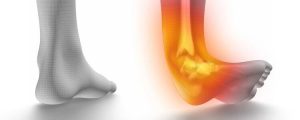Ankle Sprain: Symptoms, Causes, and Management
An ankle sprain occurs when the ligaments around the ankle become overstretched or torn. These ligaments provide stability and prevent excessive movement of the ankle joint. The severity of an ankle sprain can vary, ranging from a minor stretch to a complete tear, and it determines the recovery timeline.

Symptoms of an Ankle Sprain
Symptoms may appear immediately or develop over several days after the injury. Common symptoms include:
- Swelling and Bruising: Visible around the ankle
- Pain: Varies in intensity
- Heat and Redness: Mild warmth and discoloration in the affected area
- Loss of Movement and Strength: Reduced ability to move the ankle and foot
- Difficulty Walking: May struggle with daily activities, stairs, or uneven surfaces
- Tingling or Numbness: Sensation of pins and needles in the injured area

Causes of an Ankle Sprain
An ankle sprain typically occurs when the ligaments on the outer side of the ankle are overstretched. Common causes include:
- Rolling or Twisting the Ankle: Often during sports or sudden movement
- Direct Trauma: Such as a fall or blow to the ankle
Immediate Management of an Ankle Sprain
Managing pain and swelling is crucial in the initial stages:
- Pain Relief: Over-the-counter painkillers may help.
- Reduce Swelling: Apply ice packs, elevate the ankle, and consider compression bandages.
- Movement: Gradually begin moving the ankle within your normal range of motion to promote recovery. Stop if the pain is severe and seek medical advice.
Note: Recovery may have ups and downs; pacing your activity levels can aid the healing process.
Rehabilitation of an Ankle Sprain
The primary goals of rehabilitation are to restore:
- Muscle Strength
- Joint Stability
- Balance and Coordination
General Recovery Timeline:
- 0-2 Weeks: Improvement in swelling and movement; standing and walking become easier.
- 2-4 Weeks: Walking returns to normal; movement nearly fully restored, and swelling decreases.
- 8-12 Weeks: Day-to-day activities gradually return to normal.
Individual recovery times may vary; the key is consistent improvement.
Returning to Work
Depending on the severity of your sprain and your job’s physical demands, you may need to take time off work. You do not need to be completely symptom-free before returning. Gradually resuming normal activities helps rebuild strength and stamina.
When to Seek Further Help
If your symptoms do not improve within 8-12 weeks or worsen despite self-care measures, consult a healthcare professional. Musculoskeletal (MSK) services may be available in your area to provide specialized care.
Mental Wellbeing: Managing your mental health is crucial, as it can significantly impact your recovery process.



 4.1 Attribution Theory and Person Perception: Why We Judge People the Way We Do (Even When We’re Totally Wrong) Let’s be honest. We’ve all
4.1 Attribution Theory and Person Perception: Why We Judge People the Way We Do (Even When We’re Totally Wrong) Let’s be honest. We’ve all



